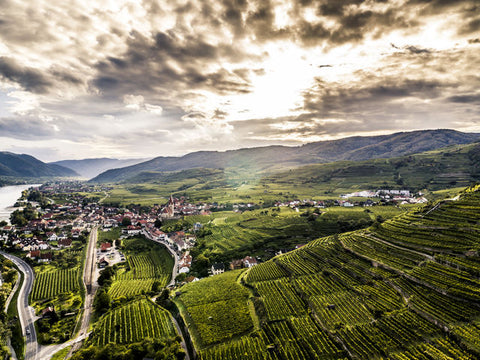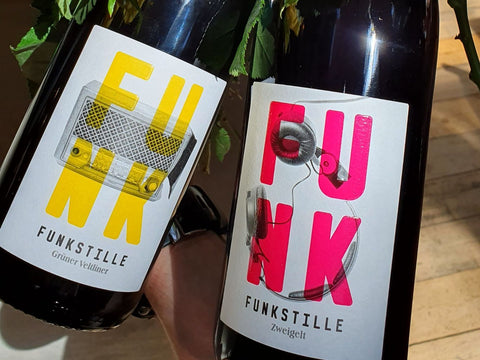Spring time has us in the mood for light, crisp white wines and juicy red wines so the time is right to feature the wines of Austria.

Austria has been producing wine for over 2000 years. Roman cellars, medieval villages, baroque monasteries and castles are all part of the typical landscape of the wine-growing regions. Family-run estates dominate the Austrian viticulture scene, and this has brought with it a great respect for the land. Environmental protection, water purity, biodiversity and the efficient use of energy and materials are all high on the agenda in this country.
Austrian wines have a freshness and concentration to their wines which is due their climate. Austria shares the same latitude as the Burgundy wine-growing region, however its central location within Europe means that it experiences much greater variations in temperature. Summer and autumn are characterised by warm, sunny days and cool nights with northerly winds, which is the key factor for the development of aromatic wines that combine freshness, a good body and subtle herbaceaous complexity. There is a distinctly Austrian character to their refreshing whites with such a concentrated flavour, or dense red wines with such a light-footed character.
Key Grape Varieties:

Gruner Veltliner
This dry and herbaceous white grape grows almost exclusively in Austria. If you enjoy dry Sauvignon Blanc, Picpoul or Riesling you'll find a lot of enjoy here. There's racy acidity, lime, lemon and peach fruit and a subtle but distinct hint of white pepper. The wines are clean, direct and very refreshing. Their freshness makes them great match for seafood of course, but it can also stand up to strong flavours of asparagus and artichoke. For a very Austrian pairing you should try it with Weiner Schnitzel.

Zweigelt
The most planted red variety in Austria, though it has only been around since 1920 when it was created by Professor Fritz Zweigelt with a cross of two other local varieties - Blaufrankisch and St Laurent. Zweigelt is a light to medium bodied, juicy red wine that is well worth a try if you enjoy Grenache or Gamay. You'll find flavors of morello cherry and raspberry and also a light bitterness that will fade after some time in a decanter.
So let's get to know the wine regions and grape varieties a little better, starting with the largest wine producing area:

Ried Achleiten, Wachau, Niederösterreich
© Austrian Wine / Robert Herbst
Niederosterreich
The Danube flows through Austria’s largest wine producing area like an artery. A great variety of wines are produced here, using many grape varieties, though predominantly use Gruner Veltliner and Zweigelt. White wines make up 78% of those produced. The area comprises eight specified winegrowing regions, each of which produces wines with their own regional style.
Wines to Try:

Funkstille are a new wine brand that aim to convert new drinkers to the joys of Austrian wine by capturing Austria’s most famous varieties and archetypal styles under some eye-popping packaging. They’ve worked with a 16th generation producer in Niederösterreich to put together a characterful range. Work in the vineyards is carried out sustainably and certified to ensure the highest standards. We're offering two of their wines.
The Gruner Veltliner is a bright and juicy white that is effortless to enjoy. The nose has aromas of ripe pear and fresh citrus flavours with subtle exotic hints. On the palate it's nicely textured with flavours of melon and grapefruit leading to a refreshing, zippy finish. This is a great wine to try with grilled fish.
Their Zweigelt is a juicy and generous red with an aroma full of vibrant berry fruits. Abundant red cherry, plum and pomegranate follow on to a joyful, bright medium-bodied palate with beautifully ripe and light tannins and touch of spice on the finish. You could enjoy this slightly chilled with grilled pork chops.

Mitterstockstall, Wagram, Niederösterreich
© Austrian Wine / Robert Herbst
Wagram
In this region of 2,400 hectares of vineyards within Niederosterriech, it is divided between two distinctly different zones. The first zone, north of the Danube, directly to the east of the Kamptal, is where the "Wagram" (a vast plateau) stretches eastwards around 30 km. The second zone, south of the Danube, is home to the small wine villages of the Tulln Basin, as well as the historic wine-growing town of Klosterneuburg, just a stone's throw away from Vienna. Gruner Veltliner accounts for 54% of the vineyards here, and Zweigelt 12%. The area is famed for its loess (clay) soils that lend a pronounced fruit-rich quality to all the wines.

Wines to try:
Eschenhof Holzer
Arnold Holzer represents the fifth generation of Holzers to farm this small estate in the heart of Wagram, which he took over in 2010 aged just twenty-three, and it's been in organic conversion since 2017.
Here is a classic, uncomplicated Zweigelt that is a great introduction to the charms of this grape variety. It has a lovely lifted fruit flavour and aroma, with violets, red fruits and black pepper spice on the finish.
The Space Invader Orange is 100% Müller-Thurgau, another native Austrian grape. The pressed juice spends 14 days with its skins extracting colour, texture and flavour. As a result we get a wine that is full of tropical aromatics such as mandarin and passionfruit with gentle tannins and texture on the palate. A great wine to pair with aromatic dishes or roast pork.
Judith Beck Pink
Light Austrian rose from native varieties Zweigelt and Blaufrankisch from renowned producer Judith Beck. Dominated by red cherries, raspberries and light peaches, it's refreshing and dry with great acidity and a hint of spice on the finish. This is a serious wine that is very fun to drink with a nibble of charcuterie in the sun.
Kamptal
With a total of 3,574 hectares under vine, and a large number of top-rated estates, Kamptal is one of Austria’s most successful winegrowing regions. Loess and primary rock are the most common soil types here. Several vineyard sites, for example the famous Heiligenstein, also have volcanic soil. DAC status is granted to Grüner Veltliner and Riesling wines here.
Wines to try:
Loimer Kamptal Riesling
The Loimer estate vineyards lie around Langenlois in the cool yet sunny Kamptal area. Divided into 100 parcels and planted on seven different soil types, the 85 hectares of vineyard offer huge potential for great complexity in the wines.
A precise and pure Riesling from Austria made using grapes handpicked from vines aged up to 50 years. There are aromas of lemon peel, ginger, and chamomile on the nose. The plate is crisp, with invigorating acidity and a mineral core. The finish is both long and elegant with silky texture. Aromatic and crisp, this offers excellent value. Try this with sea bass cooked with ginger and soy.

Martin & Anna Arndorfer, Gruner Veltliner Handcrafted
Gorgeous Grüner Veltiner made using spontaneous fermentation. It’s light and zesty in the way that makes this grape so appealing, delivering apple, pear and citrus fruit and finishing with a taut minerality and herbal note. This is great with shellfish.
Martin & Anna say "We think that winemakers are artisans, or even artists. Their work requires creativity, sensitivity and an enormous amount of personality. Everything you would attribute to an artist"
We hope you give these a try.
You can learn more about Austrian wine by visiting The Art of Wine. Down to Earth. | Austrian Wine










Leave a comment (all fields required)